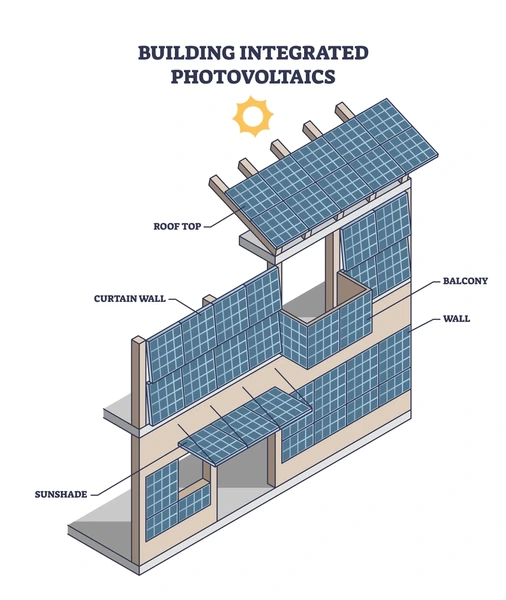Syllabus: GS 3/Environment
In News
- Recently, it has been observed that India has the potential to scale-up Building-Integrated Photovoltaics (BIPV) adoption due to its strong manufacturing base and commitment to sustainability.
BIPV (Building-Integrated Photovoltaics)
- Building-Integrated Photovoltaics (BIPV) refers to the integration of photovoltaic (solar) cells into the building envelope — including glass panels, rooftops, railings, façades, and cladding.
- These systems replace conventional materials and simultaneously generate electricity, effectively turning buildings into power generators.

Key Features
- Aesthetic Flexibility: Can be customized in terms of color, shape, size, and transparency, ensuring architectural harmony.
- Thermal Benefits: Semi-transparent panels cut solar heat gain, improving indoor energy efficiency.
- Efficient Land Use: They are ideal for residential, commercial, and public infrastructure due to their customizable, space-efficient, and visually discreet design.
- Photovoltaic Integration: Solar cells are directly incorporated into various construction elements, such as glass panels, roofing materials, and even shading devices.
Importance for India
- BIPVs are crucial for India’s urban future due to limited rooftop space and growing population.
- They allow efficient use of building surfaces like façades and balconies for solar power generation, especially in high-rises.
- For example, a south-facing façade can produce nearly four times more power than a rooftop system.
- Sunlight is absorbed by these cells and converted into electricity, feeding directly into the building’s power system.
- The panels help reduce heat ingress, cutting down on air-conditioning demand.
- BIPVs can also benefit homes without rooftop access, as seen in Germany, where balcony solar panels significantly cut electricity bills.
Challenges
- BIPV adoption in India has been limited by high initial costs, policy gaps, inadequate technical capacity, and reliance on imports.
- Low awareness, lack of dedicated incentives, and absence of clear standards also pushed BIPV out of early building-design considerations.
Suggestions and Way Forward
- With an estimated potential of 309 GW in existing buildings and vast urban growth ahead, prioritizing BIPV is key for India’s clean energy goals, requiring strong policy, innovation, and market support.
- India could increase subsidies (similar to Seoul’s 80% cost support), expand existing solar schemes to include BIPV for commercial and industrial sectors, and embed BIPV requirements in building codes.
- Pilot projects, public-private partnerships, and boosting local manufacturing through incentives and R&D are vital.
- Financial models like Renewable Energy Service Companies and long-term power agreements can improve viability.
Source :TH
Previous article
Any Law Passed By Parliament Or State Legislature Can’t Be Held To Be Contempt Of Court
Next article
News In Short-4-06-2025